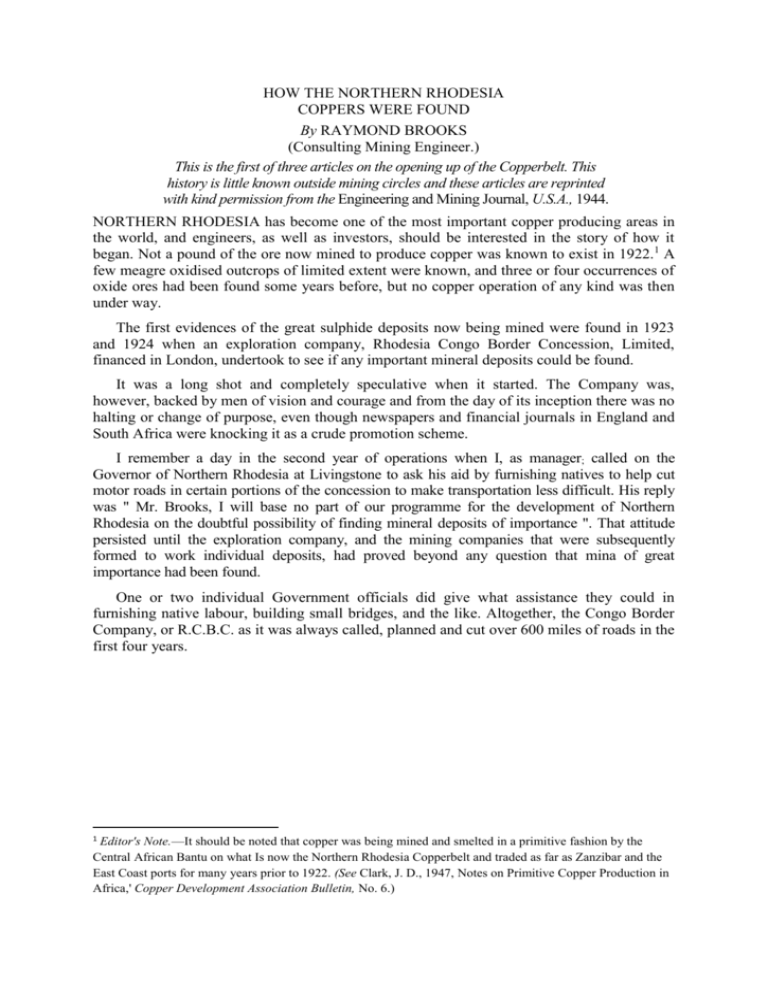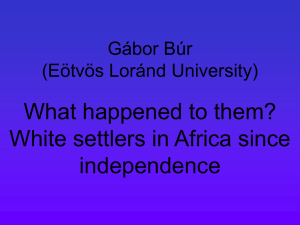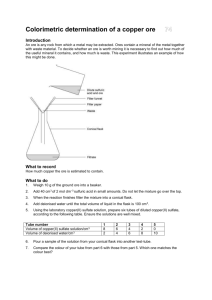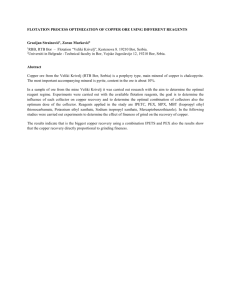HOW THE NORTHERN RHODESIA COPPERS WERE FOUND By
advertisement

HOW THE NORTHERN RHODESIA COPPERS WERE FOUND By RAYMOND BROOKS (Consulting Mining Engineer.) This is the first of three articles on the opening up of the Copperbelt. This history is little known outside mining circles and these articles are reprinted with kind permission from the Engineering and Mining Journal, U.S.A., 1944. NORTHERN RHODESIA has become one of the most important copper producing areas in the world, and engineers, as well as investors, should be interested in the story of how it began. Not a pound of the ore now mined to produce copper was known to exist in 1922.1 A few meagre oxidised outcrops of limited extent were known, and three or four occurrences of oxide ores had been found some years before, but no copper operation of any kind was then under way. The first evidences of the great sulphide deposits now being mined were found in 1923 and 1924 when an exploration company, Rhodesia Congo Border Concession, Limited, financed in London, undertook to see if any important mineral deposits could be found. It was a long shot and completely speculative when it started. The Company was, however, backed by men of vision and courage and from the day of its inception there was no halting or change of purpose, even though newspapers and financial journals in England and South Africa were knocking it as a crude promotion scheme. I remember a day in the second year of operations when I, as manager; called on the Governor of Northern Rhodesia at Livingstone to ask his aid by furnishing natives to help cut motor roads in certain portions of the concession to make transportation less difficult. His reply was " Mr. Brooks, I will base no part of our programme for the development of Northern Rhodesia on the doubtful possibility of finding mineral deposits of importance ". That attitude persisted until the exploration company, and the mining companies that were subsequently formed to work individual deposits, had proved beyond any question that mina of great importance had been found. One or two individual Government officials did give what assistance they could in furnishing native labour, building small bridges, and the like. Altogether, the Congo Border Company, or R.C.B.C. as it was always called, planned and cut over 600 miles of roads in the first four years. 1 Editor's Note.—It should be noted that copper was being mined and smelted in a primitive fashion by the Central African Bantu on what Is now the Northern Rhodesia Copperbelt and traded as far as Zanzibar and the East Coast ports for many years prior to 1922. (See Clark, J. D., 1947, Notes on Primitive Copper Production in Africa,' Copper Development Association Bulletin, No. 6.) The Company started work in May, 1923, having secured exclusive prospecting rights for three years in an area of 52,000 square miles—the entire northern portion of Noah-Western Rhodesia. It was an area the size of England, without roads or survey maps. One railroad crossed it on its way to the rich copper fields in the Congo, but the only active mine was the Broken Hill zinc-lead property, which was making slow progress. The white population in Northern Rhodesia was about 7,000, made up of scattered farmers, Government officials, railroad workers, traders and missionaries. There were only three Europeans and perhaps twenty natives working on copper properties, and these were engaged in development at Bwana Mkubwa Mine, which had made several ineffectual starts at production. The mine turned out to be a flash in the pan, but it saved a purpose in attracting attention while the big exploration job was getting under way. It is to-day abandoned as an operating mine. EARLIER DISCOVERIES. Some attempts had been made in former years to find mines north of the Zambezi by the Bechuanaland Exploration Company, by the Northern Copper Company and by the British South Africa Company, which had retained title to all of the minerals in both Northern and Southern Rhodesia. The former two and a few independent early prospectors had found occurrences of rather high-grade oxidised copper ore, and some small operations had been attempted with little success. Among the Bechuanaland Company's discoveries were Bwana Mkubwa, just mentioned, and Roan Antelope. They were found by a prospector of English origin, William C. Collier, to whom belongs much of the credit for the proof of the importance of Northern Rhodesia as a copper country. Swann Mkubwa was an obvious outcrop of oxide and carbonate ore somewhat similar to the occurrences in Katanga. One band of high-grade ore had been mined at surface. Roan Antelope appeared at surface merely as a short series of narrow, dark grey shale outcrops, carrying a little malachite in knife-blade bedding seams—nothing to give promise of important sulphide deposits below. The Bechuanaland Company did no work on the Roan bot held it for several years. During that period of occasional prospecting, two other occurrences were found by independent prospectors, one near a small village whose headman was named Nkana, and the other a few miles north-west and called Chambishi, from the name of a nearby stream. These properties were held by the discoverers. The limited outcrops at Nkana were similar to those at the Roan Antelope, and those at Chambishi were no more impressive. One copper occurrence of considerable size had been found by George Gray at the turn of the century when he went north for Cecil Rhodes and Robert Williams. His route from Victoria Falls took him through a village of a chief named Kansanshi, just south of the present boundary between the Congo and Northern Rhodesia. Kansanshi showed Gray a nearby copper mine, to which Gray gave the chief's name. This was the first important copper deposit found in Northern Rhodesia. It had been worked extensively by natives, probably for generations. Here it was that Gray camped while two of his prospectors went ahead. Only a short time after this a native chief showed one of them the Star of the Congo Mine, a deposit of almost unbelievably rich carbonate ore. About the same time other natives, 100 miles west of the “Star ", showed Gray's men the Kambove Mine. That was forty years ago, but Kambove is still producing. These and other discoveries in the Congo formed the basis for Tanganyika Concession Limited, an English company headed by Robert Williams, of which George Gray was the first manager. The Kansanshi was included in Tanganyika's holdings, though little was done to develop it until 1928. PROSPECTING IS ORGANISED. The group that formed the Rhodesia Congo Border Concession Company in London was composed of Minerals Separation Limited, A. Chester Beatty, the well-known American engineer, who resided in London and who has since become a British subject, Walter Broadbridge, an English engineer, and P. K. Homer, an American then living in London, who had been general manager of the Union Miniere du Haut-Katanga, in the Congo. Homer, who had just become consulting mining engineer for Minerals Separation, gets the credit for suggesting the idea of organised prospecting in Northern Rhodesia to see if deposits of the Katanga type of rich carbonate ores could be found on the British side of the boundary. The suggestion was considered favourably by Minerals Separation, which had engaged to design a plant for Bwana Mkubwa on principles worked out by its consulting metallurgist, W. G. Perkins. Homer was then planning steam-shovel mining at Bwana. As a start, in 1922, on the recommendation of J. H. Curle, these men in London sent C. Gordon James, an English engineer, to Donaldson and Sivewright in Johannesburg, who owned the Nkana Mine, to get an option on it. When this was obtained, application was made to the British South Africa Company for an exclusive prospecting concession in an arbitrarily selected area of 2,000 square miles surrounding Nkana and extending east to the Bwana Mkubwa holdings. This concession was obtained and the group, including James, formed Copper Ventures Limited, afterwards known as C.V. Ltd. Enough money was subscribed to keep a manager, an engineer and one white miner with some natives employed putting down prospect shafts on the strike of the meagre outcrop at Nkana, and to maintain two white prospectors and some natives for prospecting the Nkana concession. In addition, a contract was let for some shot-drill holes. No sooner had this group formed C.V. Ltd. than they decided they might as well get real concessions covering all the northern part of North-Western Rhodesia for the length of the southern boundary of the Congo and extending to Angola on the west. It took much argument to get exclusive prospecting rights, but the Chartered Company finally agreed to a three-year period with a minimum guaranteed expenditure. In addition to royalties they provided the right to fixed participation in anything found and floated as a separate company. Opposition to this concession arose in Africa, where a yell went up from individual prospectors and Government officials because of closing such an area to independent search and pegging. Actually, I think, time has proved that it was a wise move for everyone concerned, because not one of the mines that are now producing copper could have been proved or developed by independent miners, and in all probability would not have been found for years. If capital in very large amount had not been provided through stock companies to drill and explore extremely unpromising and meagre evidences of mineralisation, there would probably be no copper to-day from Northern Rhodesia. ROAN NOT INCLUDED. Here it should be said that the Roan Antelope property did not enter into the early explorations and plans of either the Rhodesia Congo Border Concessions or C.V. Limited. It was near the southern boundary of the Nkana concession and within the Congo border boundaries, but because title was held by another company there was no reason for either of the new companies to investigate it. Nkana outcrops looked as good as the Roan, and the owners had done a little shaft sinking that gave it greater appearance of possible importance. Moreover, the Rhodesia Congo Border Concessions management had its hands full hunting for possible deposits in its own great area. Ore outcrops at Chambishi were practically non-existent, but the owners had done a little trenching that exposed measures of oxidised sedimentary formation carrying copper. They showed the same type of low-grade oxide ore that had discouraged the owners of Roan and Nkana. THE NCHANGA FIND. The Congo Border Company did do some trenching on Chambishi in 1923 when it was thought that the titles of the location had lapsed, but left it to investigate its own new discovery at Nchanga further west. That decision in October, 1923, started things and it was not long before Bill Collier had pot a trench down through a swamp at Nchanga to 14 feet depth and exposed a width of 140 feet of 4½ per cent. oxidised copper ore. This exposure of commercial ore on an original discovery of the Rhodesia Congo Border Company created the first confidence in the real possibilities of Northern Rhodesia. The cable to the Board in London at the end of 1923 announcing it was good news indeed to the men who had to raise the capital. INTEREST AWAKENED. Ultimately this " River Lode " proved to be a separate segment of the main ore beds, on the opposite limb of a syncline, but the discovery served to stimulate confidence and was the primary cause of an awakening of interest in older properties like Roan Antelope, Nkana, and Chambishi. This and other subsequent developments at Nchanga led, in 1926, to the formation, by Sir Edmund Davis and associates, of three other huge concessions in Northern Rhodesia, totalling 135,000 square miles. Three companies were formed to explore them: Kasempa Concession Ltd., and Serenji Concessions Ltd., and Loangwa Concessions Ltd., the three being later merged into the Loangwa Company, although initial separate organisations started the work in each along the lines that were proving effective in the Rhodesia Congo Border Concession. One other digression from the history of the Congo Border Company is necessary to tell of the first discovery of the meagre outcrops and copper showings at Mufulira, the other great mine of that region. In June, 1923, just as we were organising the prospecting in the Rhodesia Congo Border Concession, I was also put in charge of development at the Nkana property and other prospecting in the Nkana concession. Headquarters of the Rhodesia Congo Border Concession were set up at Nkana Mine so the work in th at area was easily supervised. Two experienced prospectors named Moir and Bell, with a crew of natives, were sent out to work up the west side of Kafue River to the Congo boundary and then to return on the east side. Nothing of consequence was seen going north, but on their way south they were camped near a small tributary called the Mufulira. Here they found a small amount of malachite precipitated on peat men and sent a sample of it to me at headquarters. Shortly afterwards they discovered the limited outcrops showing meagre copper-carbonate stains. Homer and I went there and saw the outcrops, but we had adopted the policy of keeping prospectors on the move during the dry season and sending a “follow-up " man to do work on any encouraging discoveries. BWANA GETS NKANA. Before anything mote could be done at Nkana Mine or on the Nkana concession, C.V. Ltd., in London in December, 1923, made a deal whereby its rights under the concession and its option on the Nkana Mine were sold to Bwana Mkubwa. I imagine the members of the C.V. syndicate have since regretted the sale. They had invested little money and were, had they been able to look ahead, in a position to control both Nkana and Mufulira. Subsequently Rhodesian Selection Trust made an arrangement with Bwana Mkubwa by which it took over the prospecting of the Nkana concession, thereby ultimately disclosing the sulphide ore-bodies of Mufulira and gaining control. After Nkana was sold and important ore finds had been made at Nchanga it was decided to move Rhodesia Congo Border Concession headquarters to a point in our own territory where we would be closer to prospecting parties working further west. A road was cut from Nkana to a point fifty-five miles away, where headquarters for Rhodesia Congo Border Concision were established in March, 1924. NEW CENTRES OF ACTIVITY. From then until 1926 Nchanga and Mkubwa were the two centres of copper development activity in Northern Rhodesia. Investigation of the Roan had not started, and a limited programme was under way by the Bwana Mkubwa Company at Nkana under direction of C. O. Wraith, an English engineer, who had been employed by C.V. Ltd. This drilling programme in the bush, along the north-westerly strike of the copper-bearing beds at Nkana that had been exposed by C.V. Ltd., finally disclosed a better grade of oxidised ore, and, ultimately, the sulphide mineralisation on the dip at greater depth. The present Nkana workings are nearly two miles on the strike from the original outcrops. To show that Bwana Mkubwa and the discoveries at Nchanga were the stimulating influences that started things going in Northern Rhodesia and awakened interest in the older locations like Roan, Nkana, and Chambishi, it should be noted that all of the visiting engineers of that period were sent by their principals to see these two mines before starting explorations at other points. R. J. PARKER AT ROAN. From then on, credit for developments at Roan Antelope and Chambishi mines goes, without reservation, to Russell J. Parker. He did a real job of pioneering development at the Roan under difficult conditions and the results played a large part in increasing the momentum which ultimately established Northern Rhodesia as the third largest copper-producing area in the world. Again, and entirely for historical reasons, it should be said that Thorold F. Field, who =mined Roan for the American capital in late 1926, saw that mine at a time when Parka had exposed the great sulphide beds and shown beyond doubt that an important copper deposit had been found. To Field goes credit for prompt recognition of the importance of the discovery, and for immediately recommending a substantial financial participation to his American principals, though Parker had already reported similar views to his principals. Field, like four or five other well-known American engineers who had visited the country the previous year, did not visualise the possibilities of the copper-bearing formations then being investigated at Nchanga with trenches and diamond-Mill holes. The “dambo lode” had been extensively trenched, showing a big width of gaily dipping oxidised sedimentary beds carrying about 1½ per cent. copper, but the 3½ and 4½ per cent. sulphide ore that occurred deeper on the dip had not yet been exposed. NCHANGA'S HUGE RESERVES. One of these engineers stood with me on the edge of a trench and remarked that we would not find a copper mine there because no deposits of commercial importance had ever been developed anywhere in a similar formation. Three other very well-known copper men from the United States visited Nchanga for a day, and left with the same impression. In fact, their entire conversation when looking at our work was about the dangers and likelihood of being bitten by tsetse flies and contracting sleeping sickness. One of the three, in writing up the Rhodesia trip for publication afterwards, described a picnic lunch I had furnished to eat by the roadside en route to Nchanga, listing in detail the various countries that had provided the canned goods, but not mentioning the copper showings at Nchanga. Published estimates (in 1944) give reserves at Nchanga as 128,375,000 tons of ore averaging 4.66 per cent. copper. METHODS USED EFFECTIVE. My statements are made to try to bring home to miners, engineers, and mining investors certain facts about finding mines that have an important bearing on the problem of discovering and developing new resources of metals in various parts of the world to take the place of deposits that are now being depleted. It is an important question, and I hope I make it clear in this account that nothing is intended to be needlessly controversial, because systems of search have to be selected that best suit conditions. In Rhodesia there were few rock outcrops, and we had to make the best of very minor evidences of mineralisation. In the caw of Rhodesia Congo Border Concessions, the methods employed to find mines were, perhaps, old-fashioned, but they were effective. I am simply stating a fact when I say that the Congo Border Company bad no geological department during the first three years of exploration work, in which period 141 different new discoveries of ore occurrences were made. One young American geologist, named H. E. Latendressee, was employed by us in Africa in 1924, also one English engineer who had studied geology. In 1926 the directors in London finally acceded to my repeated requests for an appropriation for a small geological department which we started so as to make detailed studies of the deposits we were finding. Louis E. Reber, Jr., was borrowed from United Verde Copper Company to head it. ANGLO-AMERICAN ENTERS The Anglo-American Corporation, which had taken a financial participation in Rhodesia Congo Border Concession and Bwana Mkubwa, on recommendation from its consulting engineer, Carl It Davis, also an American, decided, in 1926, to back the Rhodesia enterprises with its full strength. Thus for the first time, Minerals Separation, Chester Beatty, and associates obtained necessary assistance to carry forward explorations and development on the required scale. With the arrangement for financing there was an agreement that Anglo-American would serve as managers of the Loangwa, Serenji, and Kasempa Concession Companies, and as technical managers for Rhodesian Congo Border Concession, Bwana Mkubwa, and Rhodesia Broken Hill. (Rhodesia Congo Border Concession’s effective prospecting methods, and the underlying theory, will be discussed in the next issue by Mr. Brooks; likewise the surprising indifference of the great American copper groups to the new discoveries.] x x x TALES FROM THE OUT-STATIONS. J. Gordon Read, C.M.G., who, although still with us, retired as Provincial Commissioner in 1944, was recognised as being a stern disciplinarian. One day he found a tiny package of native medicine tied to his table leg. It contained native medicine and some of his own hair. On investigation this was found not to be a powerful magic to kill the Bwana, but merely medicine put there by a man, who was about to have a case, in order to soften the Swarm's heart. E. E. Brooker, who was the Clerk at Mumbwa in the early 1930's, once noticed a peculiar powder sprinkled on his curry. He went to the District Commissioner complaining that the cook was trying to poison hint Again on investigation it was found that the cook had put it there merely to "make the Bwana love him." x x x The late V. R. Anley, District Commissioner, always bought two bowler hats and wore them when on leave. On his return he would give the two hats to two chiefs whom he favoured. In those days chefs were not so well clothed and there did not seem any indignity in a chief wearing nothing but a bark loin-cloth and a bowler hat. There was always competition for the bowlers.







